Effects of Compression and Porosity Gradients on Two-Phase Behavior in Gas Diffusion Layer of Proton Exchange Membrane Fuel Cells
Abstract
:1. Introduction
2. Numerical Approach
2.1. Pseudo-Potential Multi-Phase LB Model
2.2. Validation
2.3. Two-Dimensional Compressed GDL
2.4. Computational Domain and Boundary Conditions
3. Results and Discussion
3.1. Effect of Porosity Gradients on the Two-Phase Behavior within Uncompressed GDLs
3.2. Effect of Compression on the Two-Phase Behavior within Porosity Gradient GDLs
4. Conclusions
- (1)
- The water saturation within the GDL increases nearly linearly before liquid water breaks through, and the gradient of water saturation slows and eventually reaches a steady state after liquid water breakthrough to GC.
- (2)
- The linear and multilayer distribution of porosity in both uncompressed and compressed GDLs leads to a reduction in liquid water saturation, and the larger the porosity gradient, the lower the liquid water saturation. Inverted V-shaped porosity gradient GDLs aggravate the accumulation of liquid water, leading to difficulties in reactive gas transport.
- (3)
- Compression led to a reduction in porosity in the under-rib region, resulting in a reduction in the time for liquid water to break through to GC in all samples, suggesting that compression led to faster removal of liquid water.
- (4)
- Compression blocks the liquid water transport paths at the rib-GDL interface, indirectly inhibiting the formation of water films on the surface of the ribs.
- (5)
- Liquid water saturation is the lowest and liquid water breakthrough to GC is the fastest in multilayered porosity gradient GDLs. Compared to the liquid water saturation and breakthrough time in M1, the reduction is 36.9% and 44.4% for M3 without compression, 34.1% and 41.4% for M3 with CR = 20, and 42.4% and 41.0% for M3 with CR = 40%, respectively.
Author Contributions
Funding
Institutional Review Board Statement
Informed Consent Statement
Data Availability Statement
Acknowledgments
Conflicts of Interest
References
- Colombo, E.; Baricci, A.; Bisello, A.; Guetaz, L.; Casalegno, A. PEMFC performance decay during real-world automotive operation: Evincing degradation mechanisms and heterogeneity of ageing. J. Power Sources 2023, 553, 232246. [Google Scholar] [CrossRef]
- Sun, F.; Liu, H.; Chen, M.; Wang, H. Boosting oxygen transport through mitigating the interaction between Pt and ionomer in proton exchange membrane fuel cell. J. Power Sources 2023, 553, 232240. [Google Scholar] [CrossRef]
- Xiao, L.; Zhu, L.; Clökler, C.; Grünzweig, A.; Wilhelm, F.; Scholta, J.; Zeis, R.; Shen, Z.-G.; Luo, M.; Sui, P.-C. Experimental validation of pore-scale models for gas diffusion layers. J. Power Sources 2022, 536, 231515. [Google Scholar] [CrossRef]
- Song, H.; Liu, Y.-T.; Zhang, W.-S.; Zhang, X.-F.; Yin, X.; Li, J.; Wu, G.-P. Rational design of carbon network structure in microporous layer toward enhanced mass transport of proton exchange membrane fuel cell. J. Power Sources 2022, 539, 231623. [Google Scholar] [CrossRef]
- Liu, Q.; Lan, F.; Chen, J.; Zeng, C.; Wang, J. A review of proton exchange membrane fuel cell water management: Membrane electrode assembly. J. Power Sources 2022, 517, 230723. [Google Scholar] [CrossRef]
- Kulkarni, N.; Cho, J.I.S.; Rasha, L.; Owen, R.E.; Wu, Y.; Ziesche, R.; Hack, J.; Neville, T.; Whiteley, M.; Kardjilov, N.; et al. Effect of cell compression on the water dynamics of a polymer electrolyte fuel cell using in-plane and through-plane in-operando neutron radiography. J. Power Sources 2019, 439, 227074. [Google Scholar] [CrossRef]
- Cho, J.I.S.; Neville, T.P.; Trogadas, P.; Meyer, Q.; Wu, Y.; Ziesche, R.; Boillat, P.; Cochet, M.; Manzi-Orezzoli, V.; Shearing, P.; et al. Visualization of liquid water in a lung-inspired flow-field based polymer electrolyte membrane fuel cell via neutron radiography. Energy 2019, 170, 14–21. [Google Scholar] [CrossRef]
- Zenyuk, I.V.; Parkinson, D.Y.; Hwang, G.; Weber, A.Z. Probing water distribution in compressed fuel-cell gas-diffusion layers using X-ray computed tomography. Electrochem. Commun. 2015, 53, 24–28. [Google Scholar] [CrossRef] [Green Version]
- Xu, H.; Bührer, M.; Marone, F.; Schmidt, T.J.; Büchi, F.N.; Eller, J. Effects of Gas Diffusion Layer Substrates on PEFC Water Management: Part I. Operando Liquid Water Saturation and Gas Diffusion Properties. J. Electrochem. Soc. 2021, 168, 074505. [Google Scholar] [CrossRef]
- Ince, U.U.; Markötter, H.; George, M.G.; Liu, H.; Ge, N.; Lee, J.; Alrwashdeh, S.S.; Zeis, R.; Messerschmidt, M.; Scholta, J.; et al. Effects of compression on water distribution in gas diffusion layer materials of PEMFC in a point injection device by means of synchrotron X-ray imaging. Int. J. Hydrogen Energy 2018, 43, 391–406. [Google Scholar] [CrossRef]
- Shi, X.; Jiao, D.; Bao, Z.; Jiao, K.; Chen, W.; Liu, Z. Liquid transport in gas diffusion layer of proton exchange membrane fuel cells: Effects of micro-porous layer cracks. Int. J. Hydrogen Energy 2022, 47, 6247–6258. [Google Scholar] [CrossRef]
- Anyanwu, I.S.; Niu, Z.; Jin, S.; Jiao, K.; Gong, Z.; Liu, Z. Analysis of compression in uniform and non-uniform GDL microstructures on water transport. Int. J. Green Energy 2022, 19, 1389–1403. [Google Scholar] [CrossRef]
- Carrere, P.; Prat, M. Liquid water in cathode gas diffusion layers of PEM fuel cells: Identification of various pore filling regimes from pore network simulations. Int. J. Heat Mass Transf. 2019, 129, 1043–1056. [Google Scholar] [CrossRef] [Green Version]
- Gholipour, H.; Kermani, M.J.; Zamanian, R. Pore Network Modeling to Study the Impacts of Geometric Parameters on Water Transport inside Gas Diffusion Layers. J. Appl. Fluid Mech. 2021, 14, 1717–1730. [Google Scholar]
- Wang, G.; Mukherjee, P.P.; Wang, C.-Y. Optimization of polymer electrolyte fuel cell cathode catalyst layers via direct numerical simulation modeling. Electrochim. Acta 2007, 52, 6367–6377. [Google Scholar] [CrossRef]
- Jeon, D.H. Effect of channel-rib width on water transport behavior in gas diffusion layer of polymer electrolyte membrane fuel cells. J. Power Sources 2019, 423, 280–289. [Google Scholar] [CrossRef]
- Yang, M.; Jiang, Y.; Liu, J.; Xu, S.; Du, A. Lattice Boltzmann method modeling and experimental study on liquid water characteristics in the gas diffusion layer of proton exchange membrane fuel cells. Int. J. Hydrogen Energy 2022, 47, 10366–10380. [Google Scholar] [CrossRef]
- Hao, L.; Cheng, P. Lattice Boltzmann simulations of water transport in gas diffusion layer of a polymer electrolyte membrane fuel cell. J. Power Sources 2010, 195, 3870–3881. [Google Scholar] [CrossRef]
- Ira, Y.; Bakhshan, Y.; Khorshidimalahmadi, J. Effect of adding simultaneous hydrophilic and microporous layers on water transport in the gas diffusion layer of polymer electrolyte membrane fuel cell. Proc. Inst. Mech. Eng. Part A J. Power Energy 2021, 236, 61–80. [Google Scholar] [CrossRef]
- Ira, Y.; Bakhshan, Y.; Khorshidimalahmadi, J. Effect of wettability heterogeneity and compression on liquid water transport in gas diffusion layer coated with microporous layer of PEMFC. Int. J. Hydrogen Energy 2021, 46, 17397–17413. [Google Scholar] [CrossRef]
- Chen, W.; Jiang, F. Impact of PTFE content and distribution on liquid–gas flow in PEMFC carbon paper gas distribution layer: 3D lattice Boltzmann simulations. Int. J. Hydrogen Energy 2016, 41, 8550–8562. [Google Scholar] [CrossRef]
- Froning, D.; Reimer, U.; Lehnert, W. Inhomogeneous Distribution of Polytetrafluorethylene in Gas Diffusion Layers of Polymer Electrolyte Fuel Cells. Transp. Porous Media 2021, 136, 843–862. [Google Scholar] [CrossRef]
- Molaeimanesh, G.R.; Akbari, M.H. Impact of PTFE distribution on the removal of liquid water from a PEMFC electrode by lattice Boltzmann method. Int. J. Hydrogen Energy 2014, 39, 8401–8409. [Google Scholar] [CrossRef]
- Jeon, D.H. Effect of gas diffusion layer thickness on liquid water transport characteristics in polymer electrolyte membrane fuel cells. J. Power Sources 2020, 475, 228578. [Google Scholar] [CrossRef]
- Kim, K.N.; Kang, J.H.; Lee, S.G.; Nam, J.H.; Kim, C.-J. Lattice Boltzmann simulation of liquid water transport in microporous and gas diffusion layers of polymer electrolyte membrane fuel cells. J. Power Sources 2015, 278, 703–717. [Google Scholar] [CrossRef]
- Sepe, M.; Satjaritanun, P.; Zenyuk, I.V.; Tippayawong, N.; Shimpalee, S. The Impact of Micro Porous Layer on Liquid Water Evolution inside PEMFC using Lattice Boltzmann Method. J. Electrochem. Soc. 2021, 168, 074507. [Google Scholar] [CrossRef]
- Han, B.; Meng, H. Numerical studies of interfacial phenomena in liquid water transport in polymer electrolyte membrane fuel cells using the lattice Boltzmann method. Int. J. Hydrogen Energy 2013, 38, 5053–5059. [Google Scholar] [CrossRef]
- Sakaida, S.; Tabe, Y.; Chikahisa, T.; Tanaka, K.; Konno, M. Analysis of Water Transport in Anisotropic Gas Diffusion Layers for Improved Flooding Performance of PEFC. J. Electrochem. Soc. 2019, 166, F627. [Google Scholar] [CrossRef]
- Xiao, L.; Yin, Z.; Bian, M.; Bevilacqua, N.; Zeis, R.; Yuan, J.; Sui, P.-C. Microstructure reconstruction using fiber tracking technique and pore-scale simulations of heterogeneous gas diffusion layer. Int. J. Hydrogen Energy 2022, 47, 20218–20231. [Google Scholar] [CrossRef]
- Xiao, L.; Bian, M.; Zhu, L.; Duan, K.; Leng, W.; Zeis, R.; Sui, P.-C.; Zhang, H. High-density and low-density gas diffusion layers for proton exchange membrane fuel cells: Comparison of mechanical and transport properties. Int. J. Hydrogen Energy 2022, 47, 22532–22544. [Google Scholar] [CrossRef]
- Meng, L.; Zhou, P.; Yan, Y.; Guo, D. Compression properties of gas diffusion layers and its constitutive model under cyclic loading. Int. J. Hydrogen Energy 2021, 46, 15965–15975. [Google Scholar] [CrossRef]
- Zhang, H.; Rahman, M.A.; Mojica, F.; Sui, P.-C.; Chuang, P.-Y.A. A comprehensive two-phase proton exchange membrane fuel cell model coupled with anisotropic properties and mechanical deformation of the gas diffusion layer. Electrochim. Acta 2021, 382, 138273. [Google Scholar] [CrossRef]
- Zhang, T.; Li, J.; Li, Q.; Yu, M.; Sun, H. Combination effects of flow field structure and assembly force on performance of high temperature proton exchange membrane fuel cells. Int. J. Energy Res. 2021, 45, 7903–7917. [Google Scholar] [CrossRef]
- Son, J.; Lee, D.; Um, S.; Kim, Y.-B. Effect of stacking pressure on the performance of polymer electrolyte membrane fuel cell with various channel types. Energy Conv. Manag. 2021, 232, 113803. [Google Scholar] [CrossRef]
- Lee, T.; Yang, C. A parametric study on the deformation of gas diffusion layer in PEM fuel cell. J. Mech. Sci. Technol. 2020, 34, 259–268. [Google Scholar] [CrossRef]
- Zhang, H.; Zhu, L.; Harandi, H.B.; Duan, K.; Zeis, R.; Sui, P.-C.; Chuang, P.-Y.A. Microstructure reconstruction of the gas diffusion layer and analyses of the anisotropic transport properties. Energy Conv. Manag. 2021, 241, 114293. [Google Scholar] [CrossRef]
- Zhu, L.; Zhang, H.; Xiao, L.; Bazylak, A.; Gao, X.; Sui, P.-C. Pore-scale modeling of gas diffusion layers: Effects of compression on transport properties. J. Power Sources 2021, 496, 229822. [Google Scholar] [CrossRef]
- Lee, H.; Choi, C.-W.; Kang, K.-W.; Jin, J.-W. A Study on the Evaluation of Effective Properties of Randomly Distributed Gas Diffusion Layer (GDL) Tissues with Different Compression Ratios. Appl. Sci. 2020, 10, 7407. [Google Scholar] [CrossRef]
- Froning, D.; Drakselová, M.; Tocháčková, A.; Kodým, R.; Reimer, U.; Lehnert, W.; Bouzek, K. Anisotropic properties of gas transport in non-woven gas diffusion layers of polymer electrolyte fuel cells. J. Power Sources 2020, 452, 227828. [Google Scholar] [CrossRef]
- Oh, H.; Park, J.; Min, K.; Lee, E.; Jyoung, J.-Y. Effects of pore size gradient in the substrate of a gas diffusion layer on the performance of a proton exchange membrane fuel cell. Appl. Energy 2015, 149, 186–193. [Google Scholar] [CrossRef]
- Huang, Y.-X.; Cheng, C.-H.; Wang, X.-D.; Jang, J.-Y. Effects of porosity gradient in gas diffusion layers on performance of proton exchange membrane fuel cells. Energy 2010, 35, 4786–4794. [Google Scholar] [CrossRef]
- Kanchan, B.K.; Randive, P.; Pati, S. Numerical investigation of multi-layered porosity in the gas diffusion layer on the performance of a PEM fuel cell. Int. J. Hydrogen Energy 2020, 45, 21836–21847. [Google Scholar] [CrossRef]
- Zhan, N.; Wu, W.; Wang, S. Pore network modeling of liquid water and oxygen transport through the porosity-graded bilayer gas diffusion layer of polymer electrolyte membrane fuel cells. Electrochim. Acta 2019, 306, 264–276. [Google Scholar] [CrossRef]
- Wang, H.; Yang, G.; Li, S.; Shen, Q.; Liao, J.; Jiang, Z.; Espinoza-Andaluz, M.; Su, F.; Pan, X. Numerical study on permeability of gas diffusion layer with porosity gradient using lattice Boltzmann method. Int. J. Hydrogen Energy 2021, 46, 22107–22121. [Google Scholar] [CrossRef]
- Habiballahi, M.; Hassanzadeh, H.; Rahnama, M.; Mirbozorgi, S.A.; Javaran, E.J. Effect of porosity gradient in cathode gas diffusion layer of polymer electrolyte membrane fuel cells on the liquid water transport using lattice Boltzmann method. Proc. Inst. Mech. Eng. Part A J. Power Energy 2020, 235, 546–562. [Google Scholar] [CrossRef]
- Shangguan, X.; Li, Y.; Qin, Y.; Cao, S.; Zhang, J.; Yin, Y. Effect of the porosity distribution on the liquid water transport in the gas diffusion layer of PEMFC. Electrochim. Acta 2021, 371, 137814. [Google Scholar] [CrossRef]
- Shan, X.; Chen, H. Lattice Boltzmann model for simulating flows with multiple phases and components. Phys. Rev. E 1993, 47, 1815–1819. [Google Scholar] [CrossRef] [PubMed] [Green Version]
- Wang, H.; Yang, G.; Li, S.; Shen, Q.; Liao, J.; Jiang, Z.; Zhang, G.; Zhang, H.; Su, F. Effect of Binder and Compression on the Transport Parameters of a Multilayer Gas Diffusion Layer. Energy Fuels 2021, 35, 15058–15073. [Google Scholar] [CrossRef]
- Liao, J.; Yang, G.; Li, S.; Shen, Q.; Jiang, Z.; Wang, H.; Li, Z. Study of droplet flow characteristics on a wetting gradient surface in a proton exchange membrane fuel cell channel using lattice Boltzmann method. J. Power Sources 2022, 529, 231245. [Google Scholar] [CrossRef]
- Chen, L.; Luan, H.-B.; He, Y.-L.; Tao, W.-Q. Pore-scale flow and mass transport in gas diffusion layer of proton exchange membrane fuel cell with interdigitated flow fields. Int. J. Therm. Sci. 2012, 51, 132–144. [Google Scholar] [CrossRef]
- Liao, J.; Yang, G.; Shen, Q.; Li, S.; Jiang, Z.; Wang, H.; Sheng, Z.; Zhang, G.; Zhang, H. Effects of the Structure, Wettability, and Rib-Channel Width Ratio on Liquid Water Transport in Gas Diffusion Layer Using the Lattice Boltzmann Method. Energy Fuels 2021, 35, 16799–16813. [Google Scholar] [CrossRef]
- Chen, Y.; Jiang, C.; Cho, C. An Investigation of the Compressive Behavior of Polymer Electrode Membrane Fuel Cell’s Gas Diffusion Layers under Different Temperatures. Polymers 2018, 10, 971. [Google Scholar] [CrossRef] [PubMed] [Green Version]
- Jeon, D.H.; Kim, H. Effect of compression on water transport in gas diffusion layer of polymer electrolyte membrane fuel cell using lattice Boltzmann method. J. Power Sources 2015, 294, 393–405. [Google Scholar] [CrossRef]
- Zou, Q.; He, X. On pressure and velocity flow boundary conditions for the lattice Boltzmann BGK model. Phys. Fluids 1997, 9, 1591. [Google Scholar] [CrossRef] [Green Version]
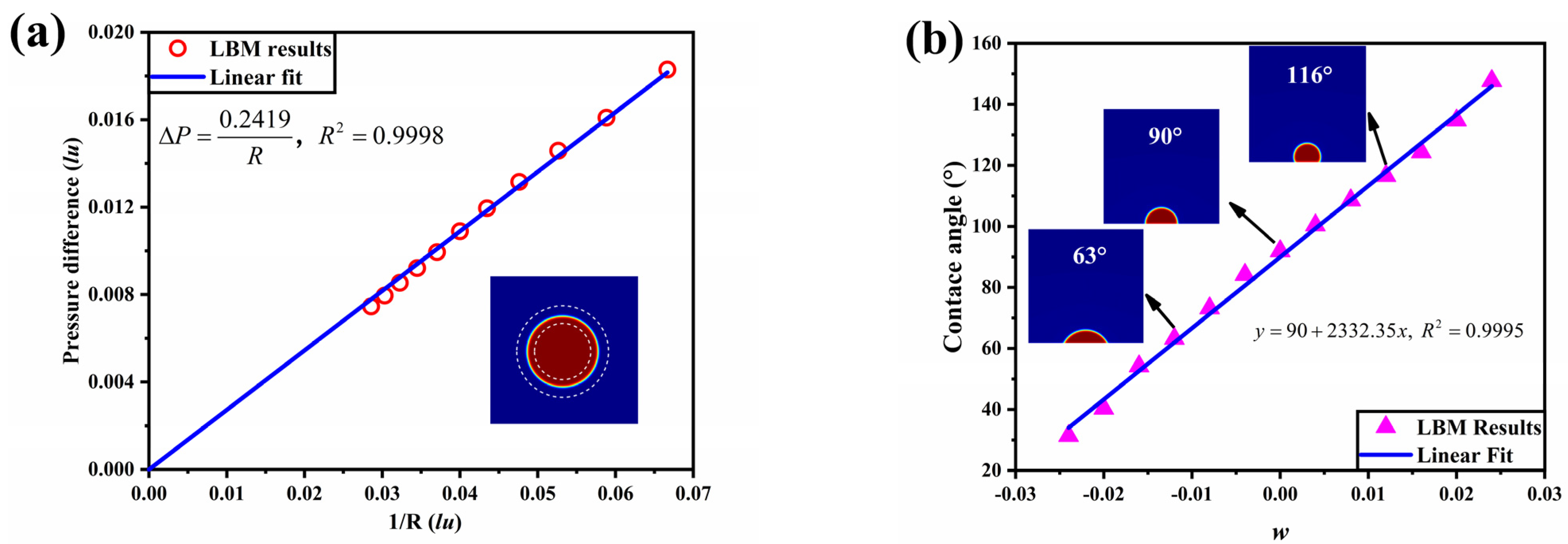

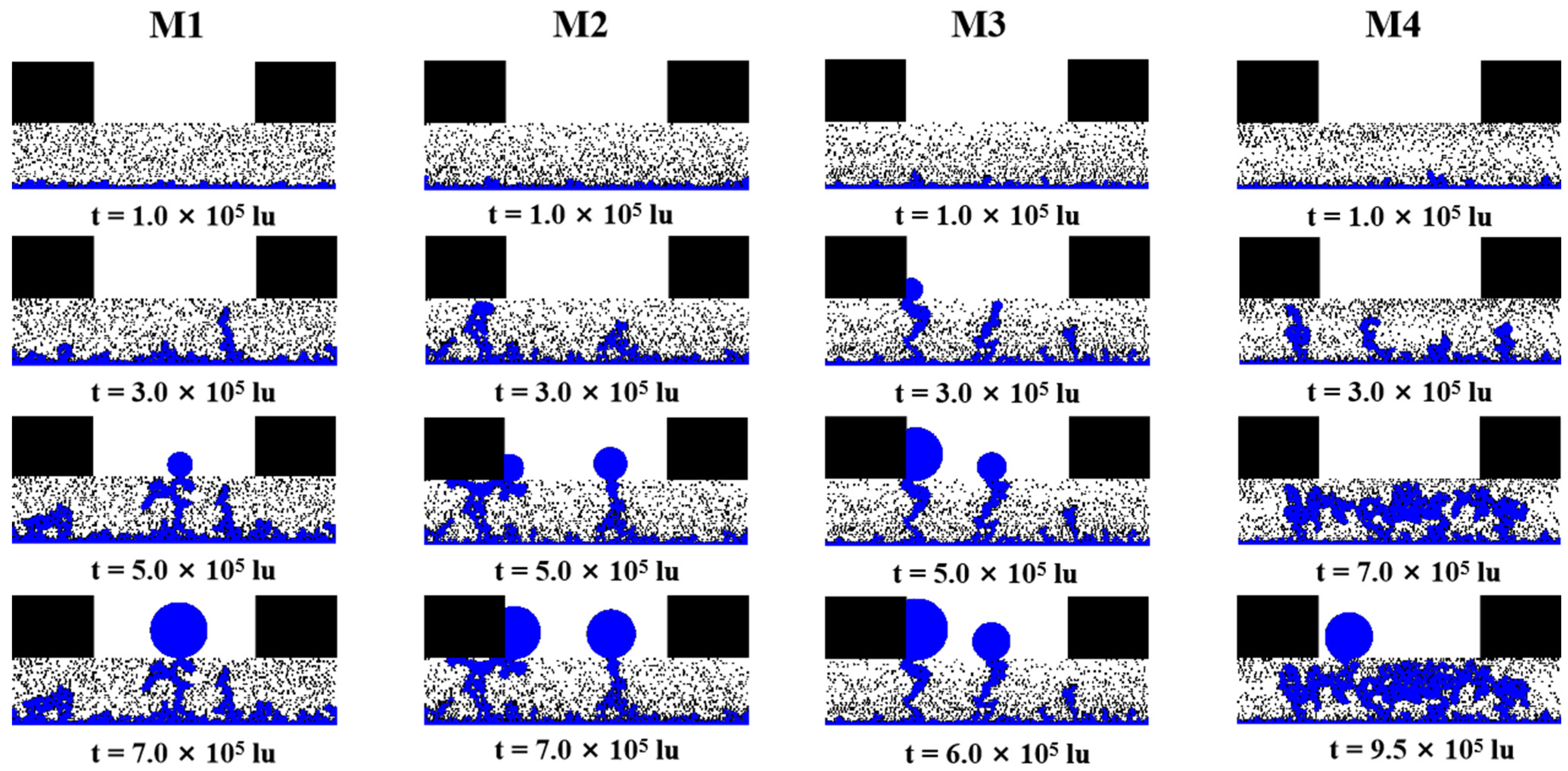
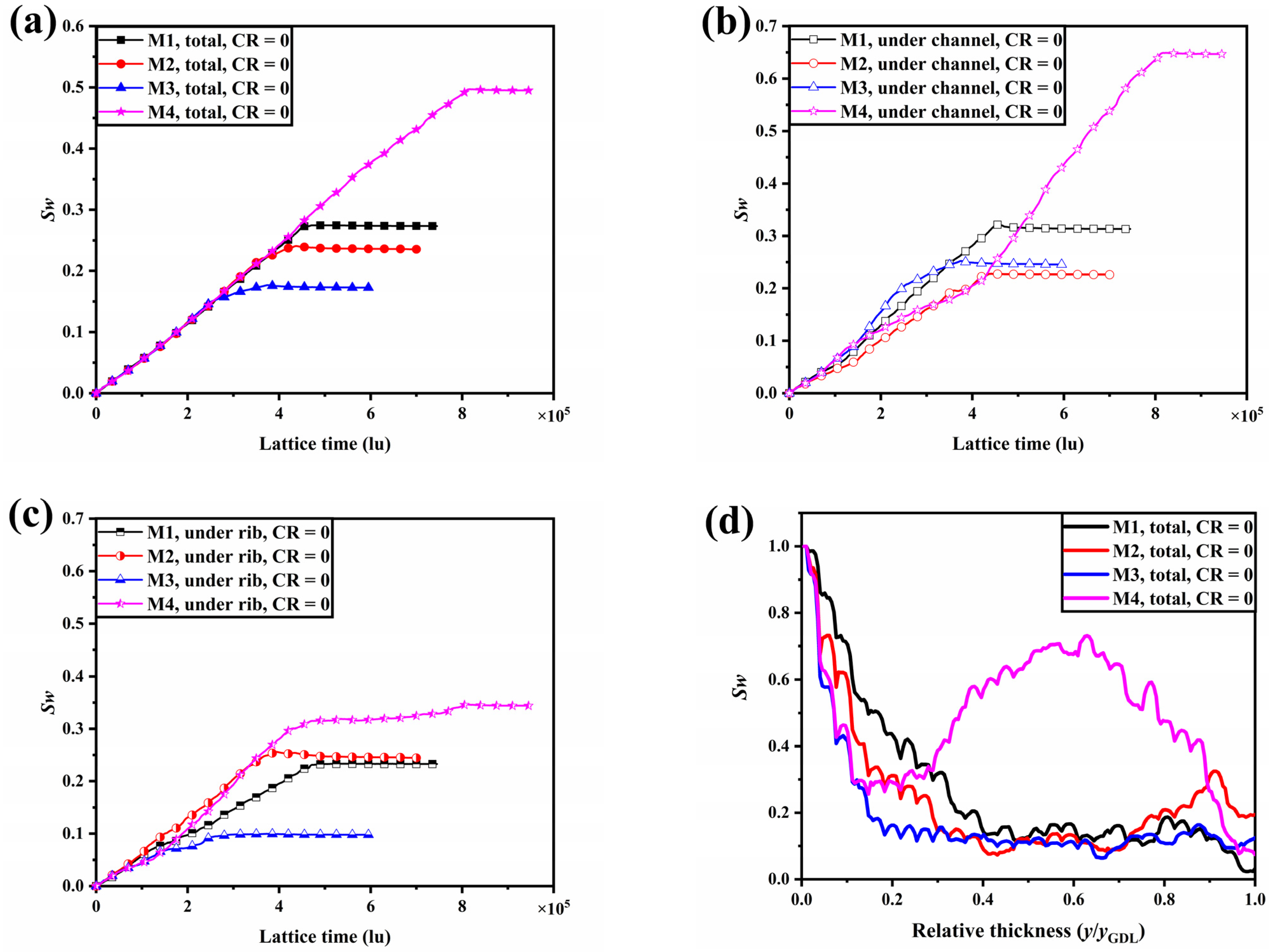
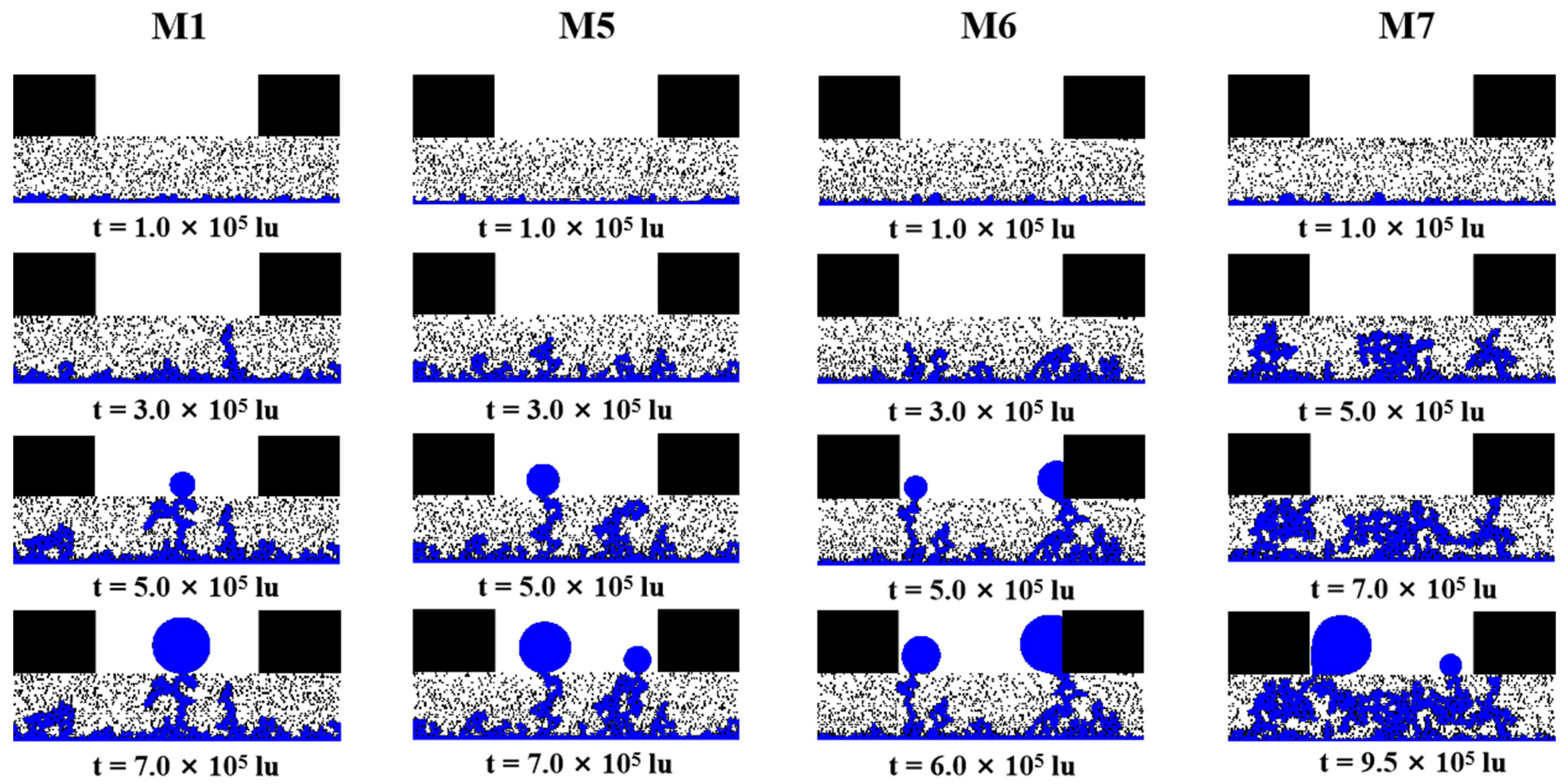


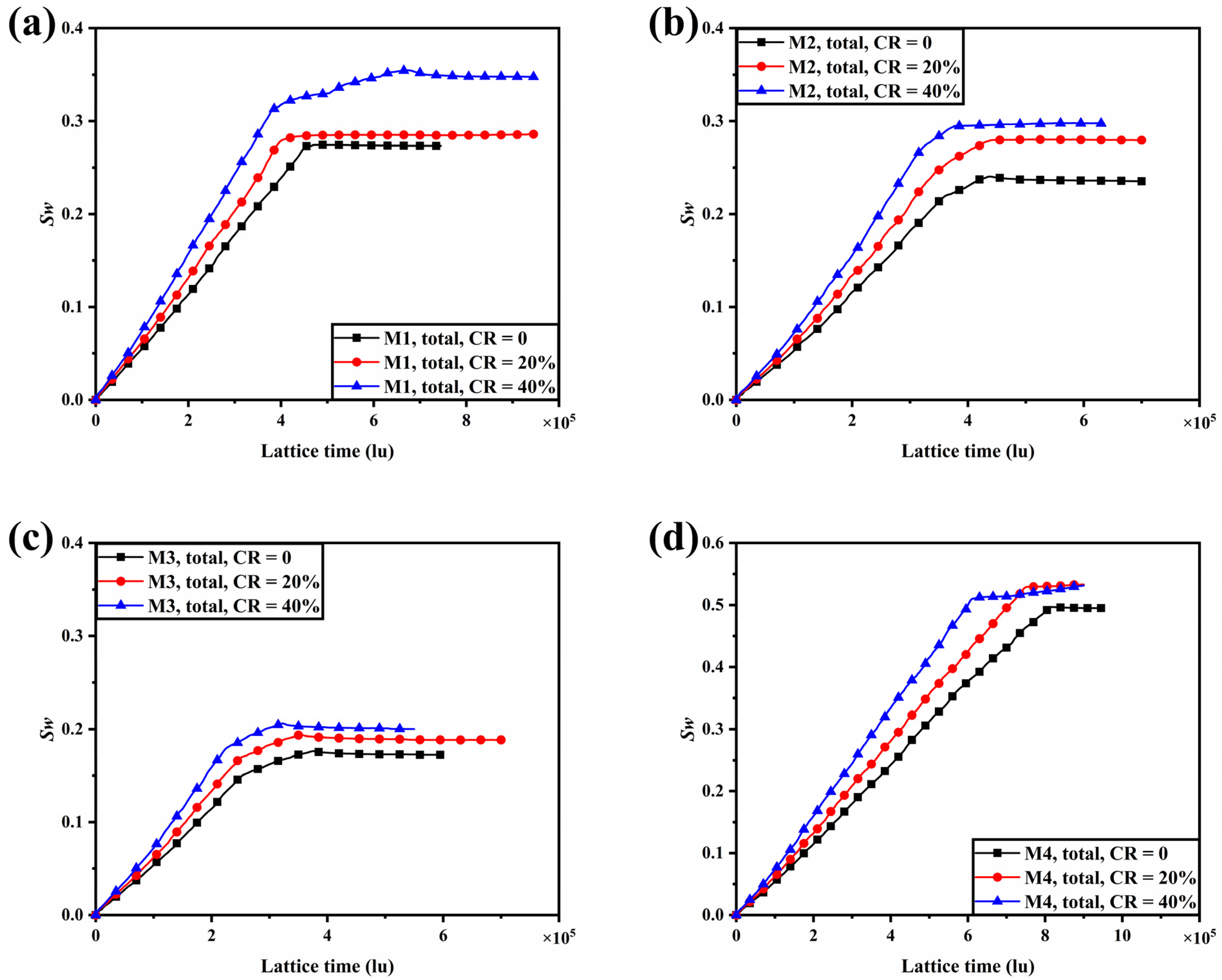

Disclaimer/Publisher’s Note: The statements, opinions and data contained in all publications are solely those of the individual author(s) and contributor(s) and not of MDPI and/or the editor(s). MDPI and/or the editor(s) disclaim responsibility for any injury to people or property resulting from any ideas, methods, instructions or products referred to in the content. |
© 2023 by the authors. Licensee MDPI, Basel, Switzerland. This article is an open access article distributed under the terms and conditions of the Creative Commons Attribution (CC BY) license (https://creativecommons.org/licenses/by/4.0/).
Share and Cite
Wang, H.; Yang, G.; Shen, Q.; Li, S.; Su, F.; Jiang, Z.; Liao, J.; Zhang, G.; Sun, J. Effects of Compression and Porosity Gradients on Two-Phase Behavior in Gas Diffusion Layer of Proton Exchange Membrane Fuel Cells. Membranes 2023, 13, 303. https://doi.org/10.3390/membranes13030303
Wang H, Yang G, Shen Q, Li S, Su F, Jiang Z, Liao J, Zhang G, Sun J. Effects of Compression and Porosity Gradients on Two-Phase Behavior in Gas Diffusion Layer of Proton Exchange Membrane Fuel Cells. Membranes. 2023; 13(3):303. https://doi.org/10.3390/membranes13030303
Chicago/Turabian StyleWang, Hao, Guogang Yang, Qiuwan Shen, Shian Li, Fengmin Su, Ziheng Jiang, Jiadong Liao, Guoling Zhang, and Juncai Sun. 2023. "Effects of Compression and Porosity Gradients on Two-Phase Behavior in Gas Diffusion Layer of Proton Exchange Membrane Fuel Cells" Membranes 13, no. 3: 303. https://doi.org/10.3390/membranes13030303
APA StyleWang, H., Yang, G., Shen, Q., Li, S., Su, F., Jiang, Z., Liao, J., Zhang, G., & Sun, J. (2023). Effects of Compression and Porosity Gradients on Two-Phase Behavior in Gas Diffusion Layer of Proton Exchange Membrane Fuel Cells. Membranes, 13(3), 303. https://doi.org/10.3390/membranes13030303






